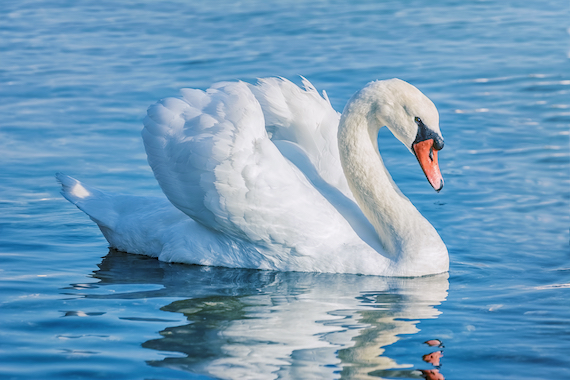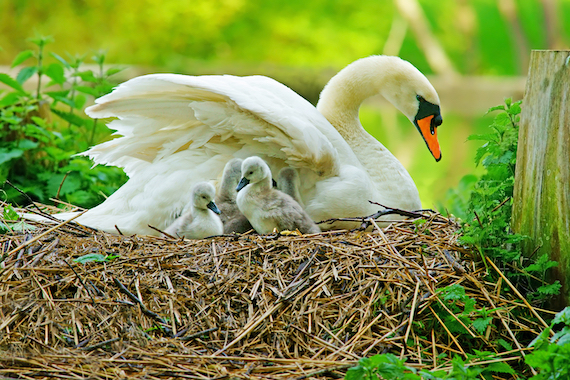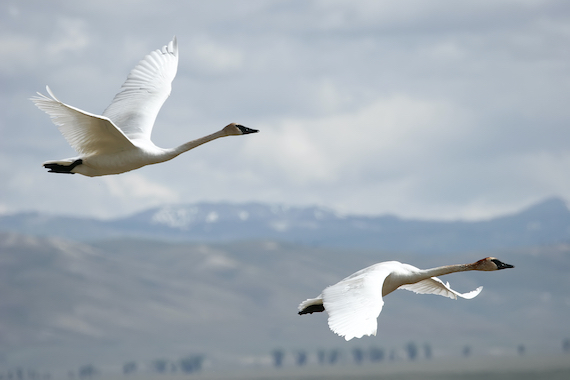
| Kingdom | Animalia |
| Phylum | Chordata |
| Class | Aves |
| Order | Anseriformes |
| Family | Anatidae |
| Subfamily | Anserinae |
| Genus | Cygnus |
| Species | 6 species |
| Niche | Herbivorous migratory waterfowl |
| Length | 40 – 71 inches (1 – 1.8 m) |
| Wingspan | 53 – 98 inches (1.3 – 2.5 m) |
| Weight | 7.7 – 30 lb (3.5 – 13.6 kg) |
| Lifespan | 12 – 30 years |
| Social Structure | Monogamous pairs |
| Conservation Status | Least concern |
| Preferred Habitat | Temperate lakes, rivers and wetlands |
| Average Clutch Size | 3 – 12 |
| Main Food Item | Aquatic and submerged plants, insects, molluscs |
| Predators | Foxes and mink |
The Basics
The swan is a group of 6 species of waterfowl native to temperate regions of North America, Eurasia, Australia and southern South America. They are the largest extant members of the waterfowl family, Anatidae, which also includes ducks and geese. Four species of swan are native to the Northern Hemisphere and all have purely white plumage. The Southern Hemisphere is home to two species; the black swan of Australia that has mainly black plumage and the black-necked swan of southern South America that has a white body with black neck and head.

Swans feed in the water either by dipping their head underwater or by upending their whole bodies to reach deeper. These birds are almost entirely herbivorous and mainly eat the leaves and stems of submerged vegetation, as well as roots and tubers obtained by digging into the substrate. During winter, certain species also eat agricultural crop remnants such as grains and potatoes. Juvenile swans might initially supplement their diets with insects and crustaceans to increase their protein intake, before gradually switching to herbivory as they mature.
Reproduction
The swan’s preferred breeding habitats include shallow ponds, undisturbed lakes, slow rivers, wetlands and marshes. They also require large areas of water or open land for taking off and landing due to their large size and weight. Swans nest on mounds of aquatic vegetation that they typically build close to the water’s edge. Given that swans are monogamous and mate for life, a single pair will often use the same nest repeatedly, repairing it as necessary each year. Both parents normally participate in building the nest and taking care of the eggs.
Female swans typically lay 3 – 8 eggs, although certain species sometimes lay as many as 12. It is thought that the largest species of swan, the trumpeter swan, lays the largest eggs of any flying bird at 2.9 inches (73 mm) wide, 4.5 inches (113.5 mm) long, and 11.3 ounces (320 g). The incubation period lasts for 30 – 45 days, during which time the male and female will take turns incubating the eggs in some species, whereas in other species the male will stand guard while the female incubates. Although only certain species of swan are territorial year-round, all species exhibit territorial behavior during the breeding season and will aggressively protect their nests from any animal that passes by.

Cygnets hatch with brown or gray plumage and are able to swim at only a few days old, however they might ride on their parents’ backs when venturing long distances into deep water. Although cygnets are usually capable of feeding themselves after only a few weeks, parents continue to care for their young until they fledge the nest at around 3 – 5 months old in most species. Fledging takes much longer in black swans though, and parents must care for their young for 9 months before they are able to fly. In contrast, tundra swan juveniles are thought to fledge as soon as 40 – 45 days after hatching and likely develop faster than other swan species in order to survive in their cold habitat.
Fun Facts about Swans
Swans may be known for their beauty, but they also exhibit a number of interesting adaptions that demonstrate specific biological concepts.
Migration
Several species of swan are at least partially migratory, making use of separate summer and winter ranges. Migration involves the long-distance movement of individuals on a seasonal basis, and occurs in all major animal groups including birds, mammals, reptiles, amphibians, fish, insects and crustaceans. A number of factors might influence the migration of different species, including local climate, food availability, season, mating requirements or life stage. For example, wildebeest migrate annually across the Serengeti to follow the availability of grazing material, whilst humpback whales migrate each winter to give birth in the warm tropical waters of the Pacific.
Both the whooper swan and tundra swan are fully migratory, breeding at northern latitudes during summer and moving to more southern latitudes to spend the winter. Similarly, it is thought that both the trumpeter swan and black-necked swan are migratory over most of their ranges. However, the mute swan is only partially migratory, with resident populations existing in western Europe. The black swan is nomadic, meaning it shows erratic patterns of migration dependent on the climatic conditions for any given year, with rainfall being especially important.

Brittle Bones
Swans are some of the largest flying birds in the world and the trumpeter swan is the heaviest extant bird native to North America. As result, these birds need all the help they can get in order to fly successfully. All flying birds have a honeycomb-like bone structure that aids flight by making them as light as possible. However, this has been taken to the extreme in swans, meaning they have weaker bones than other animals that are more vulnerable to breakages.
The weak bones of swans provide an example of an evolutionary trade-off, in which a beneficial change in one trait is linked to a detrimental change in another trait. This occurs when multiple traits cannot be optimized simultaneously, perhaps due to genetic or energetic constraints, for example. In birds, body size, bone density and flying ability cannot all be optimized at once due to the laws of physics. However, different species have solved this problem differently, with hummingbirds evolving small size to reduce their weight and swans evolving weak bones to the same end, whilst ostriches have evolved to stop flying altogether.
Mutual Courtship
Swans mate for life and typically form pair bonds even before they reach sexual maturity. For example, trumpeter swans normally begin breeding around 4 – 7 years old, but have been found to form monogamous pair bonds from as early as 20 months old. Pair bonds are maintained year-round, even in gregarious species such as the tundra swan, which congregates in large flocks on wintering grounds. In many socially monogamous bird species, including swans, both males and females participate in courtship rituals before mating to provide reassurance of and strengthen these pair bonds.

All six swan species perform a variation of a courtship ritual in which the male and female face each other and bow their heads, forming a heart shape with both of their necks. Black swans also have specific feathers used for courtship and all six species are very vocal during their displays. For example, trumpeter swans make a honking sound whilst they perform synchronized swimming and head bobbing. Tundra swans and whooper swans are more subdued, however, and call softly to each other once they have mated.
